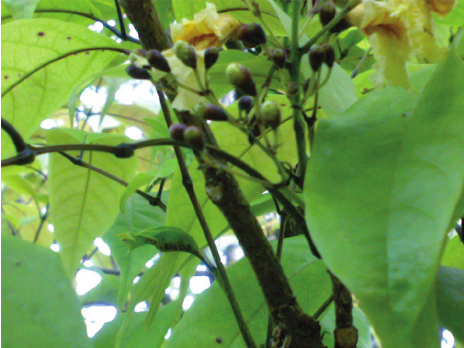panduraphali :

HISTORICAL AND MYTHOLOGICAL REVIEW:
Patala (पाटल) is mentioned by Panini in Ashtadhyayi.Taxonomical Classification
Kingdom: Plantae - Plants
Subkingdom: Tracheobionta - Vascular plants
Superdivision: Spermatophyta - Seed plants
Division: Magnoliophyta - Flowering plants
Class: Magnoliopsida - Dicotyledons
Family: Bignoniaceae
Genus: Stereospermum
Species: Stereospermum suaveolens
Allied species:
- Charak Samhita - Sothahara - Anti-Inflammatory group of herbs
- Sushrut Samhita - Aragvadhadi, Brihat panchamula, Adhobhagahara
- Vagbhata - Aragvadhadi
VERNACULAR NAMES
Sanskrit: padal - patil, patala, amotha, maghudhut, faleruha, krishanvrinta, kuberakshi, kalsthali, alivallam and tamarpushpi.English: trumpet flower tree, yellow snake tree , Rose Flower Fragrant
Hindi: Padhal, Podal
Telugu: Kaligottu, Padiri, Kaligottu, Kokkesa, Podira
Bengali: Parul
Marathi: Padal
Oriya: Boro, Patulee
Gujarathi: Padal
Tamil: Padari
Malayalam: Padiri
Kannada: Padramora
Punjabi: Padala
Assamese: Parul
Varities:
Definition
Synonyms
Synonyms in Ayurveda: panduraphali, bhuriphali, patali, patalaRasa: Kashaya Tikta
Guna: Laghu Ruksha
Veerya: Sheetha
Vipaka: Katu
Karma: Kaphahara Pittahara Vatahara
It has various therapeutic properties like diuretic, cardiac tonic, anti-inflammatory. Its different parts are used in the management of different disorders. Its roots are useful in the balance of vata and their related disorders. Its flowers are cold in potency and are useful in the management of blood related disorders.
Cultivation:
Large deciduous tree, 9-18 m. highPropogation:
This species is usually propagated through seeds but has a very poor rate of germination.Phytochemistry:
Plant contains naphthoquinone lapachol. Root bark contains 6-sitosterol, n-triacontanol. Root, heart-wood contains lapachol, dehydro-a-lapachone and dehydrotectol and the Leaves contain flavone glycoside scutellarein, dinatin-7-glucuronide. Seeds of the plant contains non-drying oil, Bitter substances, sterols, glycosides and glyco alkaloids. Its Root bark contains bitter substance. Lapachol isolated which showed highly significant activity against walker 256 carcinoma. Lapachol, Scutellarein, Dehydrotectol, ceryl alcohol, oleic, Palmitic, Stearic acid.PHARMACOLOGY:
Parts used for medicinal purpose
Bark, Flower, Leaves, Seed, ,Dosage:
Commercial value:
Morphology:
Root occurs in about 6-9 cm long, 1-1.5 cm thick cut pieces, cylindrical, externally brown to creamy, rough due to vertical fissures, cracks, ridges and transverse fine lenticels, internally dark brown, lamellation or stratification due to presence of concentric bands of fibres; fracture tough and fibrous; odour, not distinct; taste, bitter.Histology:
Root cork consists of 25-35 layers of rectangular cells with 3-5 stratified layers, lignification being more prominent where the stratification starts, arranged with 1-3 tangential rows of narrow cells alternating with 3-5 tangential rows of wider cells; cork cambium composed of 1 -2 layers of tangentially elongated cells; secondary cortex arranged more or less radially, becomes polyhedral to isodiameteric in inner region, a few cells getting converted into stone cells which are regular in shape and show projection; secondary phloem wide, forms cerantenchyma between two obliquely running rays; some rays and phloem cells get converted into irregular, polygonal shaped stone cells, measuring 10- 150 n in width, phloem parenchyma being intact; medullary rays multiseriate, being 3-4 cells wide, and 8-11-15 cells high; fibres tapering, pointed or slightly blunt, with a small peg-like projection at both ends; sieve tube gets collapsed in outer region forming strips of ceratenchyma; a few small microsphenoidal crystals of calcium oxalate present in phloem parenchyma and rays; secondary xylem wide having usual elements; vessels simple, pitted, lignified; fibres large, pointed, aseptate; rays multiseriate, 2- 3 cells wide.Geographical distribution:
It is found in North circus and Deccan, in deciduous forests; Western Ghats and also in deciduous forests, in the hills of Mysore, Malabar and Travancore, Scarce.ECOLOGICAL ASPECT:
Moist parts, Deciduous forests, Humid climate, Hot climate, Lateritic loamy soils, Sandy black soils.Plant conservation:
Stereospermum suaveolens DC. is a valuable medicinal tree species, now placed in the threatened category due to its overexploitation.General Use:
Therapeutic Uses:
It is bitter and astringent in taste and anusna (not very hot) in potency. It helps to balance all three doshas and manages the anorexia (aaruchi), asthma and bronchitis (shwas), inflammation and edema (shoth), vomiting (vaman), hiccups, blood disorders (raktprokap) and excessive thirst (trisha).Systemic Use:
Root bark is an ingredient of Dasamula. Decoction of roots used in intermittent and puerperal fevers and affections of the brain. Stem bark diuretic and tonic. Flowers given with honey to stop hiccup.Administration:
Root,root bark, flowers and tender fruits are used in medicine.Pharmacological:
Clinical trials:
Thirumalaisamy B, Prabhakaran GS, Marimuthu K & Chatterjee TK, Antihyperlipidemic activity of the ethyl-acetate fraction of Stereospermum suaveolens in streptozotocin-induced diabetic rats, J Pharmacopun, 16 (2013) 23-29.Research:
Shukla S, Shukla SK & Mishra SK, In vitro regeneration of multipurpose medicinal tree Stereospermum suaveolens–factors controlling the in vitro regeneration, J Biotechnol Biomater, 13 (2012) 1-3.Precautions:
Safe to use in lactation period and in children.Toxicity studies:
No known side effects.Use in other system of medicine:
Stereospermum suaveolens (Roxb.) DC. is used in folk medicine for the treatment of diabetes, pain, fever, inflammations and asthma. The major phytoconstituents found in the plant bark are lapachol and apigenin exhibit various pharmacological activities.CONCLUSION:
Patala (Stereospermum suaveolens DC.) alleviates Kapha and Vata. It is slightly pungent. It is constipative and digestive stimulant. It is regarded as cooling, diuretic and tonic.Stereospermum chelonoides is an deciduous tree native to South Asia. In Theravada Buddhism, this plant is said to have used as the tree for achieved enlightenment, or Bodhi by third Lord Buddha calledAyurvedic Formulations:
Common Ayurvedic Formulations of panduraphali with their IndicationsBrahma Rasayana
Sukumaram Kashayam
Photos of panduraphali - ,
- Courtesy: https://www.researchgate.net/figure/Stereospermum-suaveolens-Roxb-DC-leaves-with-flowers_fig2_264073988
- Courtesy: https://www.researchgate.net/figure/Stereospermum-suaveolens-Roxb-DC-Bark_fig3_264073988
- Courtesy: https://upload.wikimedia.org/wikipedia/commons/9/97/Stereospermum_suaveolens.JPG
- Courtesy: https://plantslive.in/product/buy-stereospermum-suaveolens-kalagari-padal-paroli-padiri-poopatiri-plant-online-india/
- Courtesy: http://plantillustrations.org/illustration.php?id_illustration=130431&SID=0&mobile=0&code_category_taxon=0&size=1
KEY WORDS: panduraphali Stereospermum suaveolens, Stereospermum colais Ham. ex. Dillw.
- » Classification and names of panduraphali
- » Synonyms and definitions of panduraphali
- » Drug Properties of panduraphali
- » Chemical Constituents of panduraphali
- » Standardization of panduraphali
- » Parts used and Dosage of panduraphali
- » Morphology and Histology of panduraphali
- » Distribution and Conservation of panduraphali
- » Cultivation of panduraphali
- » panduraphali in the market
- » Medicinal Uses of panduraphali
- » Researches and clinical trails of panduraphali
- » panduraphali in other sytems of medicine
- » Ayurvedic formulations with panduraphali
- » Images of panduraphali

















